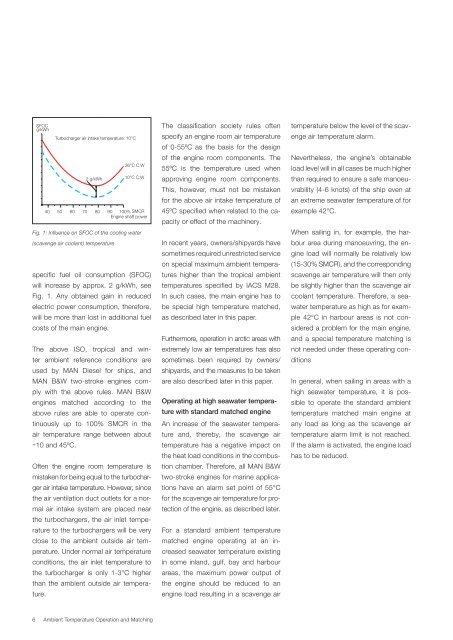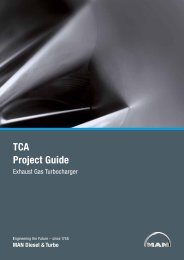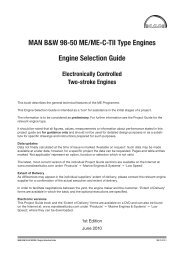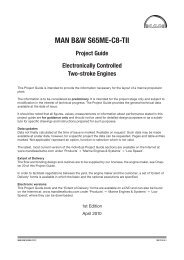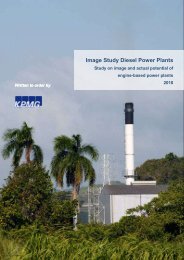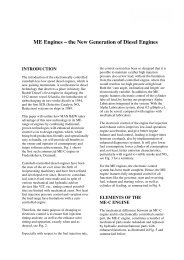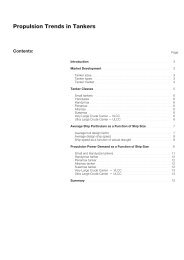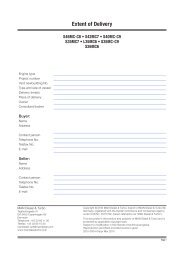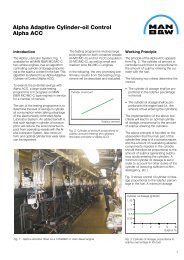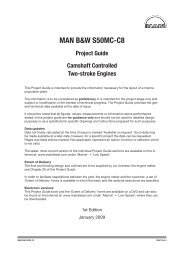Ambient Temperature Operation and Matching - MAN Diesel & Turbo
Ambient Temperature Operation and Matching - MAN Diesel & Turbo
Ambient Temperature Operation and Matching - MAN Diesel & Turbo
You also want an ePaper? Increase the reach of your titles
YUMPU automatically turns print PDFs into web optimized ePapers that Google loves.
SFOC<br />
g/kWh<br />
specific fuel oil consumption (SFOC)<br />
will increase by approx. 2 g/kWh, see<br />
Fig. 1. Any obtained gain in reduced<br />
electric power consumption, therefore,<br />
will be more than lost in additional fuel<br />
costs of the main engine.<br />
The above ISO, tropical <strong>and</strong> win-<br />
ter ambient reference conditions are<br />
used by <strong>MAN</strong> <strong>Diesel</strong> for ships, <strong>and</strong><br />
<strong>MAN</strong> B&W two-stroke engines com-<br />
ply with the above rules. <strong>MAN</strong> B&W<br />
engines matched according to the<br />
above rules are able to operate con-<br />
tinuously up to 100% SMCR in the<br />
air temperature range between about<br />
-10 <strong>and</strong> 45ºC.<br />
Often the engine room temperature is<br />
mistaken for being equal to the turbochar-<br />
ger air intake temperature. However, since<br />
the air ventilation duct outlets for a nor-<br />
mal air intake system are placed near<br />
the turbochargers, the air inlet tempe-<br />
rature to the turbochargers will be very<br />
close to the ambient outside air tem-<br />
perature. Under normal air temperature<br />
conditions, the air inlet temperature to<br />
the turbocharger is only 1-3°C higher<br />
than the ambient outside air tempera-<br />
ture.<br />
<strong>Turbo</strong>charger air intake temperature: 10°C<br />
2 g/kWh<br />
Fig. 1: Influence on SFOC of the cooling water<br />
(scavenge air coolant) temperature<br />
36°C C.W<br />
10°C C.W<br />
40 50 60 70 80 90 100% SMCR<br />
Engine shaft power<br />
6 <strong>Ambient</strong> <strong>Temperature</strong> <strong>Operation</strong> <strong>and</strong> <strong>Matching</strong><br />
The classification society rules often<br />
specify an engine room air temperature<br />
of 0-55ºC as the basis for the design<br />
of the engine room components. The<br />
55ºC is the temperature used when<br />
approving engine room components.<br />
This, however, must not be mistaken<br />
for the above air intake temperature of<br />
45ºC specified when related to the ca-<br />
pacity or effect of the machinery.<br />
In recent years, owners/shipyards have<br />
sometimes required unrestricted service<br />
on special maximum ambient tempera-<br />
tures higher than the tropical ambient<br />
temperatures specified by IACS M28.<br />
In such cases, the main engine has to<br />
be special high temperature matched,<br />
as described later in this paper.<br />
Furthermore, operation in arctic areas with<br />
extremely low air temperatures has also<br />
sometimes been required by owners/<br />
shipyards, <strong>and</strong> the measures to be taken<br />
are also described later in this paper.<br />
Operating at high seawater tempera-<br />
ture with st<strong>and</strong>ard matched engine<br />
An increase of the seawater tempera-<br />
ture <strong>and</strong>, thereby, the scavenge air<br />
temperature has a negative impact on<br />
the heat load conditions in the combus-<br />
tion chamber. Therefore, all <strong>MAN</strong> B&W<br />
two-stroke engines for marine applica-<br />
tions have an alarm set point of 55°C<br />
for the scavenge air temperature for pro-<br />
tection of the engine, as described later.<br />
For a st<strong>and</strong>ard ambient temperature<br />
matched engine operating at an in-<br />
creased seawater temperature existing<br />
in some inl<strong>and</strong>, gulf, bay <strong>and</strong> harbour<br />
areas, the maximum power output of<br />
the engine should be reduced to an<br />
engine load resulting in a scavenge air<br />
temperature below the level of the scav-<br />
enge air temperature alarm.<br />
Nevertheless, the engine’s obtainable<br />
load level will in all cases be much higher<br />
than required to ensure a safe manoeu-<br />
vrability (4-6 knots) of the ship even at<br />
an extreme seawater temperature of for<br />
example 42°C.<br />
When sailing in, for example, the har-<br />
bour area during manoeuvring, the en-<br />
gine load will normally be relatively low<br />
(15-30% SMCR), <strong>and</strong> the corresponding<br />
scavenge air temperature will then only<br />
be slightly higher than the scavenge air<br />
coolant temperature. Therefore, a sea-<br />
water temperature as high as for exam-<br />
ple 42°C in harbour areas is not con-<br />
sidered a problem for the main engine,<br />
<strong>and</strong> a special temperature matching is<br />
not needed under these operating con-<br />
ditions<br />
In general, when sailing in areas with a<br />
high seawater temperature, it is pos-<br />
sible to operate the st<strong>and</strong>ard ambient<br />
temperature matched main engine at<br />
any load as long as the scavenge air<br />
temperature alarm limit is not reached.<br />
If the alarm is activated, the engine load<br />
has to be reduced.


